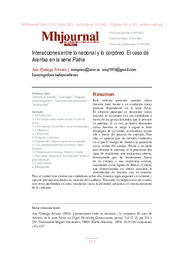Por favor, use este identificador para citar o enlazar este ítem:
https://hdl.handle.net/11000/26378Registro completo de metadatos
| Campo DC | Valor | Lengua/Idioma |
|---|---|---|
| dc.contributor.author | Quiroga Álvarez, Ana | - |
| dc.date.accessioned | 2022-03-28T09:17:20Z | - |
| dc.date.available | 2022-03-28T09:17:20Z | - |
| dc.date.created | 2021-01-31 | - |
| dc.identifier.citation | Vol. 12 (2021) | es_ES |
| dc.identifier.issn | 1989-8681 | - |
| dc.identifier.uri | http://hdl.handle.net/11000/26378 | - |
| dc.description.abstract | Este artículo pretende analizar cómo Arantxa hace frente a su condición como persona dependiente en la serie Patria. El objetivo principal es demostrar cómo Arantxa se comunica con sus cuidadoras a través de los gestos limitados que le permite su parálisis. A su vez, se busca demostrar cómo Arantxa se niega a seguir la línea ideológica de su madre, revelándose contra ella a través del proceso de sujeción. Para ello, se apuesta por un método cualitativo en el que el cuerpo de Arantxa se posiciona como centro del análisis. Frente a su lucha por alcanzar la sujeción, se le presentan dos tipos de resistencia: una resistencia interna, determinada por las limitaciones físicas de su cuerpo; y una resistencia externa, cristalizada en las figuras de Miren y Celeste, que determinarían en última instancia la interrelación de Arantxa con su entorno. Pese al control que ejercen sus cuidadoras sobre ella, Arantxa logra imponer su voluntad y apostar por una resolución no violenta del conflicto. Tomando el cuerpo como eje central, este texto profundiza en otras cuestiones como la identidad nacional o el cuestionamiento de la violencia. | es_ES |
| dc.description.abstract | This paper aims to analyze how Arantxa faces her condition as a disabled person in the seriesPatria. The main objective is to illustrate how Arantxa communicates with her caregivers through limitedgestures allowed by her paralysis. At the same time, this essay seeks to demonstrate how Arantxa rejects her mother’s ideology, as she turns against her through the process of subjection. To this effect, the body of Arantxa will be at the center of the analysis, developed through a qualitative approach. As Arantxa tries to achieve the subjection, she faces two kinds of resistance: an internal resistance, determined by her body’s physical limitations; and an external resistance, crystallized into the figures of Miren and Celeste, who ultimately influence the way in which Arantxa interacts with her social setting. Despite the control exerted on Arantxa by her caregivers, Arantxa imposes her wish to resolve the conflict in a non-violent way. Using the body as the centre of the analysis, this paper delves into other questions such as national identity or the questioning of violence. | es_ES |
| dc.format | application/pdf | es_ES |
| dc.format.extent | 21 | es_ES |
| dc.language.iso | spa | es_ES |
| dc.publisher | Universidad Miguel Hernández de Elche | es_ES |
| dc.rights | info:eu-repo/semantics/openAccess | es_ES |
| dc.rights | Attribution-NonCommercial-NoDerivatives 4.0 Internacional | * |
| dc.rights.uri | http://creativecommons.org/licenses/by-nc-nd/4.0/ | * |
| dc.subject | historia de España | es_ES |
| dc.subject | sociología | es_ES |
| dc.subject | lenguaje cinematográfico | es_ES |
| dc.subject | relaciones interpersonales | es_ES |
| dc.subject | incapacidad | es_ES |
| dc.subject.other | CDU::3 - Ciencias sociales | es_ES |
| dc.title | Interacciones entre lo nacional y lo corpóreo. El caso de Arantxa en la serie Patria | es_ES |
| dc.type | info:eu-repo/semantics/article | es_ES |
| dc.identifier.doi | 10.21134/mhjournal.v12i.1327 | - |
| dc.relation.publisherversion | https://doi.org/10.21134/mhjournal.v12i.1327 | - |

Ver/Abrir:
1327-Texto del artículo-6138-1-10-20210729.pdf
847,73 kB
Adobe PDF
Compartir:
 La licencia se describe como: Atribución-NonComercial-NoDerivada 4.0 Internacional.
La licencia se describe como: Atribución-NonComercial-NoDerivada 4.0 Internacional.
.png)